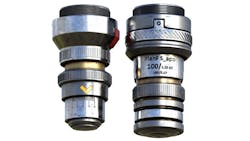Deep Dive into Optics Blog: Objective Lenses
An objective lens is an important component of a microscopy or imaging system for a range of science research, biological, industrial, and general lab applications. An objective lens is located closest to the object and plays a central role in imaging an object onto the human eye or an image sensor for discerning the object’s details.
Objective Types
According to the optical performance or degree of aberration corrections, objective lenses are generally classified into five basic types:
- Achromatic Objectives: the least expensive objectives with chromatic aberration corrected for red and blue light, and spherical aberration corrected for green light.
- Plan Achromatic Objectives: A type of microscope objective that has a flat field in addition to chromatic aberration corrected for two wavelengths.
- Plan Fluorite Objectives (Plan Semi-Apochromat): multi-purpose objectives that provide flat field images and better chromatic aberration, and spherical aberration is corrected for 2 wavelengths.
- Plan Apochromatic Objectives: comparing with Plan Fluorite Objectives, Plan Apochromatic Objectives have improved transmission between 400nm and 100nm, and higher level corrections for the field curvature, chromatic aberration, and spherical aberration.
- Super Apochromatic Objectives: deliver diffraction-limited performance over the entire field of view from the visible to near infrared region.
To learn more about microscope objectives, click here.
Important Specifications
Degree of Aberration Correction or resolution: objectives with high degree of aberration correction delivers high resolution image over the field of view.
Magnification: the ability of a microscope to produce a larger image. Objective with high magnification gives a very detailed image of the specimen.
Numerical Aperture: Objective with high NA collects more amount of the light emitted/scattered from the specimen and has the ability of resolve fine specimen detail at a fixed distance.
Conjugate distance: objectives are corrected for a particular projection distance. In an infinity-corrected optical system, a light beam emitted from a specimen passes through the objective lens which does not form an image and enters as an infinity parallel beam in the tube lens which forms a real image.
Cover glass: Usually objectives are corrected for a particular cover glass. The standard thickness for cover glasses is 0.17 millimeters.
Immersion Media: it is importance to use the correct media (such as water, oil, air/dry) that is specified by the objective.
Working Distance: The distance between the front end of a microscope objective and the surface of the workpiece at which the sharpest focusing is obtained. For getting a good image with the specified magnification, putting the objective at the right position is very important.
Parfocal length: the distance from the shoulder of the objective to the sample plane.
Working wavelength(s): Objectives are corrected for a particular wavelength or wavelengths. Shorter wavelengths yield higher resolution.
To learn more about microscopes and objective lenses, click here
